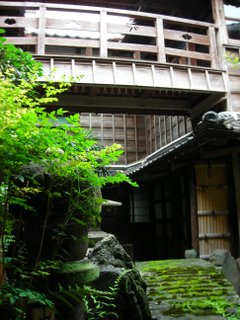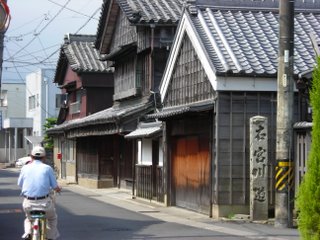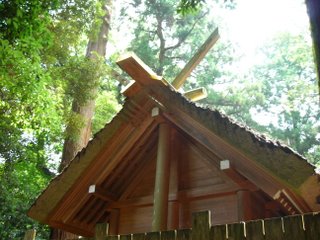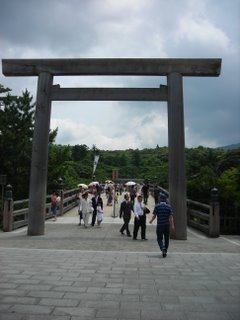 This past weekend I took an overnight trip down to Ise. After a beautiful sunset while on the train, I had dinner in town and spent the night at the Hoshide-kan Ryokan, which had a very pleasant little garden, a hot bath, was super quiet, and had a good breakfast in the morning. I started my sightseeing day walking the Kawasaki Kaiwai, a street lined with old merchant houses near the ryokan. I then headed over to Ise Jinjya (shrine), one of the largest and most important Shinto shrines in Japan. Ise is divided into two parts, the outer and inner shrines. I first went to the outer shrine, which dates from the 5th century. It was quite pleasant to walk through the ancient forest and see the structures, which are frequently rebuilt to maintain purity. Each of the buildings has an empty plot of land next to it where the next round of building will be done. The shrines were quite crowded with people, including pilgrims at the outer shrine. I took a bus to the inner shrine, which is the more sacred of the two, housing the sun goddess Amaterasu, who is the ancestor of the imperial family, and dates from around the 3rd century. The site here was quite large, and the grounds were beautiful, including a river where the pilgrims purify before visiting the shrine. As with all shrines, one can not enter the buildings or even the area inside the fences, which at Ise is reserved for select priests and the imperial family. Interestingly, just outside of the shrine was a huge and bustling commercial street selling food and all sorts of tourist trinkets. After taking the bus back to the station, I went to Futami, where I visited the Meoto-iwa, or Wedded Rocks, another Shinto site of two rocks considered to be male and female and joined by sacred ropes that are renewed each year. This was also a great excuse to stand on the other side of the Pacific, or at least close to it, and see some water. :)
This past weekend I took an overnight trip down to Ise. After a beautiful sunset while on the train, I had dinner in town and spent the night at the Hoshide-kan Ryokan, which had a very pleasant little garden, a hot bath, was super quiet, and had a good breakfast in the morning. I started my sightseeing day walking the Kawasaki Kaiwai, a street lined with old merchant houses near the ryokan. I then headed over to Ise Jinjya (shrine), one of the largest and most important Shinto shrines in Japan. Ise is divided into two parts, the outer and inner shrines. I first went to the outer shrine, which dates from the 5th century. It was quite pleasant to walk through the ancient forest and see the structures, which are frequently rebuilt to maintain purity. Each of the buildings has an empty plot of land next to it where the next round of building will be done. The shrines were quite crowded with people, including pilgrims at the outer shrine. I took a bus to the inner shrine, which is the more sacred of the two, housing the sun goddess Amaterasu, who is the ancestor of the imperial family, and dates from around the 3rd century. The site here was quite large, and the grounds were beautiful, including a river where the pilgrims purify before visiting the shrine. As with all shrines, one can not enter the buildings or even the area inside the fences, which at Ise is reserved for select priests and the imperial family. Interestingly, just outside of the shrine was a huge and bustling commercial street selling food and all sorts of tourist trinkets. After taking the bus back to the station, I went to Futami, where I visited the Meoto-iwa, or Wedded Rocks, another Shinto site of two rocks considered to be male and female and joined by sacred ropes that are renewed each year. This was also a great excuse to stand on the other side of the Pacific, or at least close to it, and see some water. :)












No comments:
Post a Comment